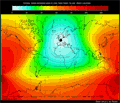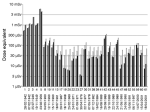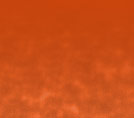|
AIRCREW DOSIMETRY For daily maps of radiation and GLE alert system, see SiGLERT web page. Ionizing radiation is not a threat to human body as long as it remains at low level. Indeed, everyone is exposed to a mean radiation dose of 2.4 mSv (milliSievert) each year from natural sources such as telluric radiation or the concentration of radon in our houses. When the altitude increases, the dose increases either and the cosmic radiation becomes the main radiation contributor.  Indeed the earth atmosphere is a shield protecting us from high-energy particules coming from space. As it strikes the atmosphere, a given particule will hit an atom in the air, creating a cascade of many secondary particules of lower energy, down to the ground. As the height and density of the atmosphere above us is smaller at aircraft altitude, the risk to encounter high-energy secondary particules there is higher. As a consequence, the radiation dose is hundred times more intense there. Indeed the earth atmosphere is a shield protecting us from high-energy particules coming from space. As it strikes the atmosphere, a given particule will hit an atom in the air, creating a cascade of many secondary particules of lower energy, down to the ground. As the height and density of the atmosphere above us is smaller at aircraft altitude, the risk to encounter high-energy secondary particules there is higher. As a consequence, the radiation dose is hundred times more intense there.The primary particules are both galactic cosmic rays (GCR) and solar particules (mainly protons). The galactic component is permanent but modulated by the solar activity in the course of the 11-year solar cycle whereas the solar component is sporadic, and due to solar activity. In 1996, the European Commission included the exposure of aircraft crew to cosmic radiation as occupational exposure (directive 96/29/EURATOM). Airline companies have now the legal requirement to check that the air crew members do not receive a dose higher than 100 mSv over 5 years with a maximum of 50 mSv for a given year. The pregnant air crew, as the foetus is more exposed, should not receive more than 1 mSv until the end of her pregnancy. To estimate the dose received on a given flight, 3 important parameters should be taken into account:
 To get a rough estimate of the dose one would receive flying from Paris to any other location in the world, one can check the following map. Note that the flight plans are not taken into account in this case and many of these flight paths are not even possible because to long for a commercial flight. The way points are deduced from the orthodromic path between two points on a sphere. Check also other departure locations: New-York, Tokyo, Buenos Aires and Equata . To get a rough estimate of the dose one would receive flying from Paris to any other location in the world, one can check the following map. Note that the flight plans are not taken into account in this case and many of these flight paths are not even possible because to long for a commercial flight. The way points are deduced from the orthodromic path between two points on a sphere. Check also other departure locations: New-York, Tokyo, Buenos Aires and Equata .SiGLE semi-empirical model The model SiGLE, developed at Paris observatory, is based on doses measured on board Concorde flights. Indeed, to prevent excess of dose, Concorde had dosimeters permanently in operation during its flights.  The data are completed with measurements onboard subsonic flights and results of theoretical calculations. The model enables to calculate the dose received onboard a given flight, during every GLEs observed with neutron monitors. It has been applied to the GLEs observed since 1942 (see publications, 2003). Among the 75 GLEs observed in 82 years, only a few have been source of more than 1 mSv onboard a subsonic flight from Paris to San Francisco, one of the more exposed flights. Nevertheless, the most significant ones are taken into account in the Sievert system since 2000. The bar chart summarizes the contribution of GLEs to the total dose along this route for most of the GLEs since 1942. In the recent GLE history, the one that occured in january 2005 is the subject of a specific page. In 2018 SiGLE has evolved into a real time tool, particularly in the context of setting up centers dedicated to space weather monitoring by ICAO. SiGLERT, is able to automatically detect GLEs and compute corresponding radiation doses. See also this page dedicated to SIGLERT. The data are completed with measurements onboard subsonic flights and results of theoretical calculations. The model enables to calculate the dose received onboard a given flight, during every GLEs observed with neutron monitors. It has been applied to the GLEs observed since 1942 (see publications, 2003). Among the 75 GLEs observed in 82 years, only a few have been source of more than 1 mSv onboard a subsonic flight from Paris to San Francisco, one of the more exposed flights. Nevertheless, the most significant ones are taken into account in the Sievert system since 2000. The bar chart summarizes the contribution of GLEs to the total dose along this route for most of the GLEs since 1942. In the recent GLE history, the one that occured in january 2005 is the subject of a specific page. In 2018 SiGLE has evolved into a real time tool, particularly in the context of setting up centers dedicated to space weather monitoring by ICAO. SiGLERT, is able to automatically detect GLEs and compute corresponding radiation doses. See also this page dedicated to SIGLERT.
 was developed by [DGAC] and partners: [IRSN] , [l'Observatoire de Paris] , [IPEV] was developed by [DGAC] and partners: [IRSN] , [l'Observatoire de Paris] , [IPEV] | |







